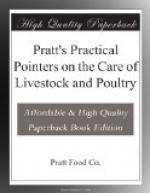-------------------------------------------------------
---------- Port Dover, Canada.
After a long experience I find Pratts Poultry Regulator to be absolutely the best tonic to keep a flock of poultry in condition. Just as soon as I find a pen is not doing well, I use the Regulator in their mash. Almost immediately I notice their appetites improve, their combs redden and they lay better. I have also made trial of your other remedies and I find them all absolutely reliable.
JOHN S. MARTIN ------------------------------------------------------------
-----
For a flock of one hundred or more birds the New Jersey Multiple Unit Laying House is to be recommended. Each unit is twenty feet square, accommodating a hundred fowls. Similar units may be added for each hundred additional birds. The drawing on page 48 shows two units.
In this house the front studs are nine feet high, rear studs are four and a half feet high.
Simple, inexpensive furnishings are best. The cuts show home-made equipment which will meet all practical requirements.
Getting the Eggs
Early-hatched, well-matured pullets are the most dependable layers during the fall and early winter months. Some few yearling hens may continue to lay fairly well during their molting period, but, as a rule, egg production drops with the feathers and does not begin until the new coat of plumage is completed and the system readjusted. So yearlings, taken as a whole, do little toward filling the egg-basket until January or later.
Get the early-hatched pullets into winter quarters by late September or early October before they begin to lay. But be sure the house is fully prepared in advance. Clean house! Disinfect thoroughly with a strong solution of Pratts Poultry Disinfectant. Kill every germ. Avoid possible loss.
-------------------------------------------------------
---------- Cherokee, Iowa.
I have used Pratts Poultry Regulator for the last twenty years and always had the best of results. It is a great egg producer and the best feed to keep little chicks strong and guard off that terrible disease, bowel complaint. In fact, I cannot do without it.
GEO. WM. LYON. ------------------------------------------------------------
-----
Get Fall and Winter Eggs
It is most desirable that the flock begin egg production before the weather becomes severe. Get the laying habit established while the season is favorable, and it is comparatively easy to maintain it. And, as production will not commence until the layers are fully matured, the pullets must be hatched early to give ample time for them to make the needed growth.
As a rule, it takes about seven months to mature pullets of the general purpose breeds and six months for the egg breeds. Therefore, March and April chicks of the former, and April and May chicks of the latter, are most valuable. This is a general rule. Some poultrymen are experts in this matter of growing chicks and can bring them to laying maturity in less time.




